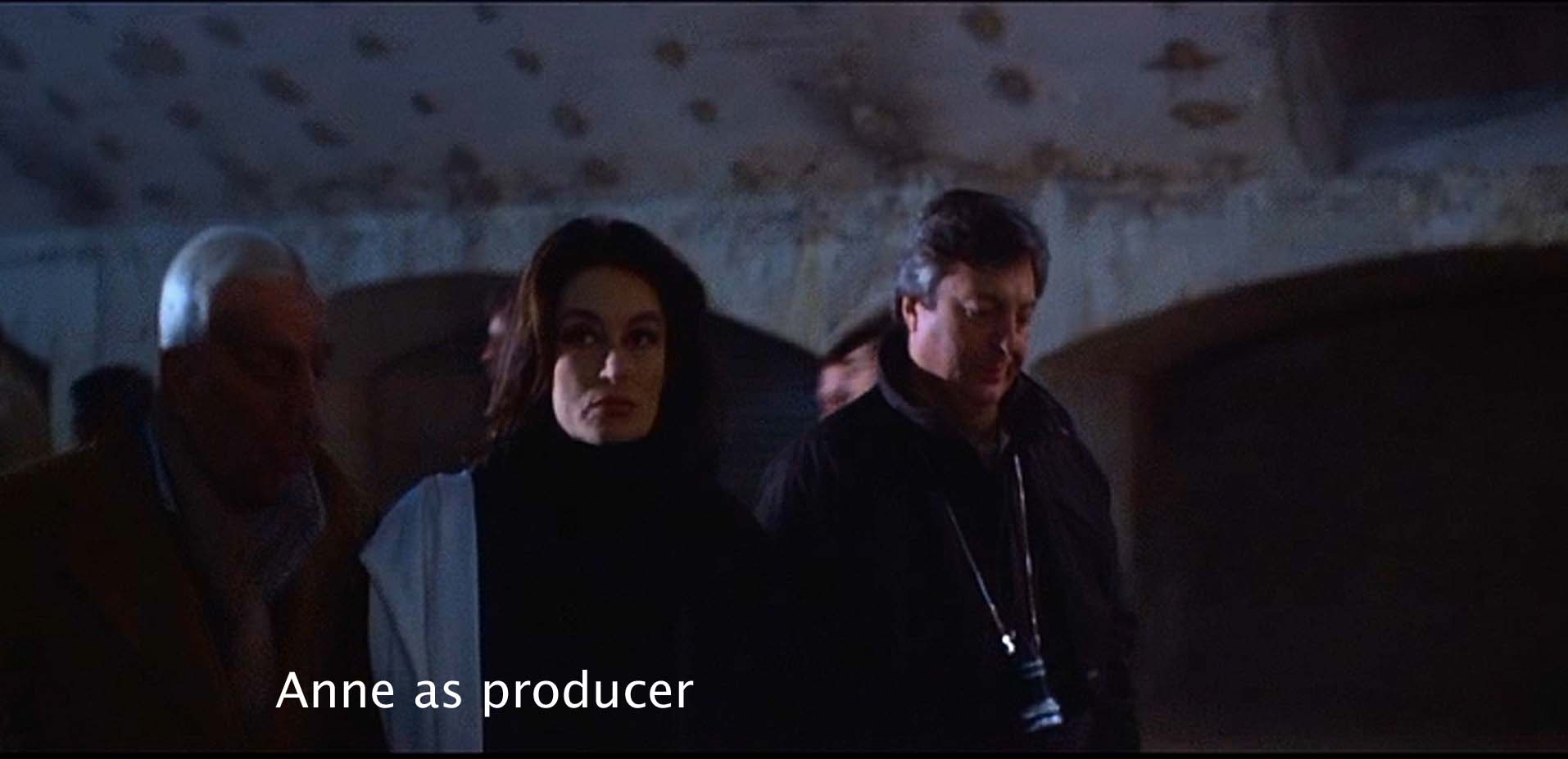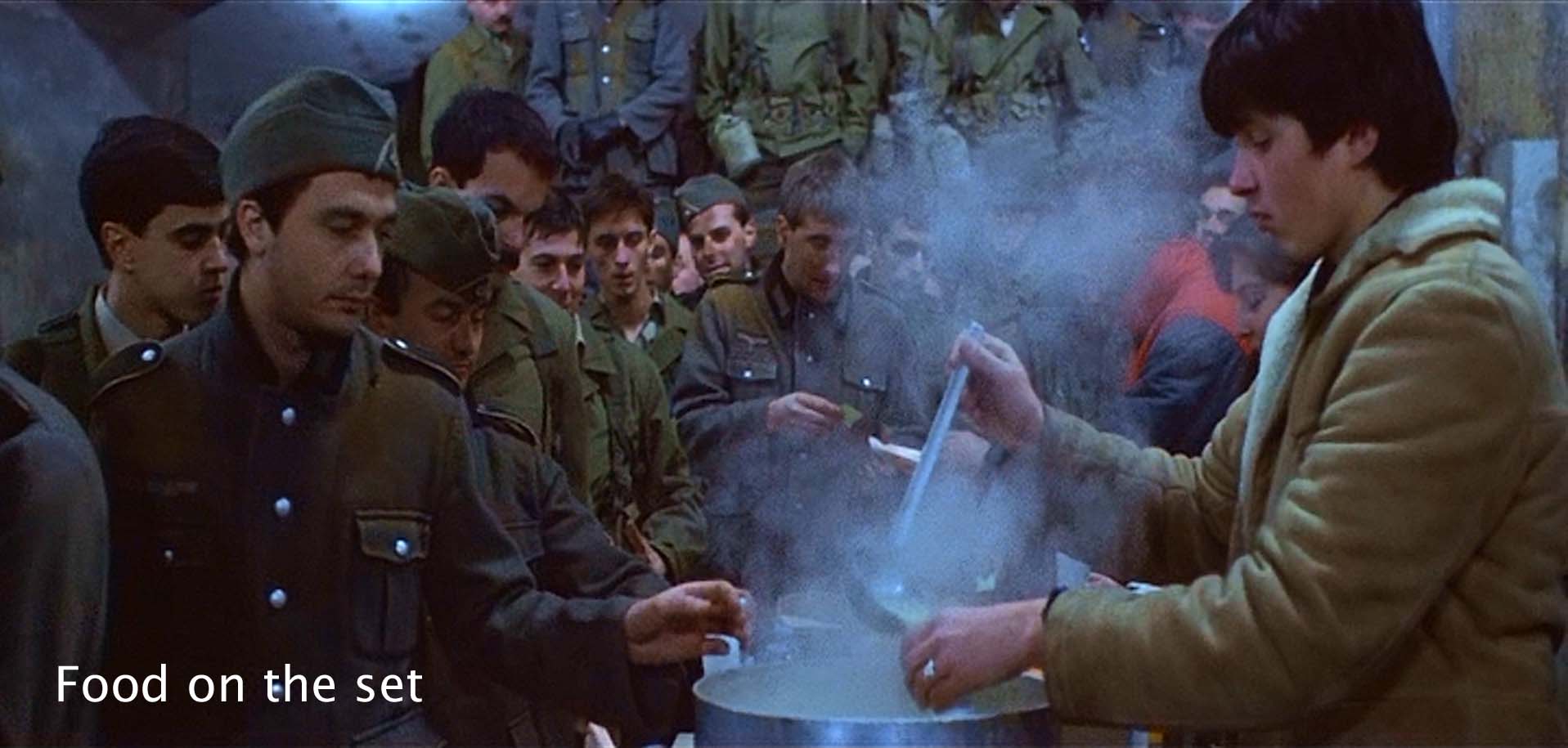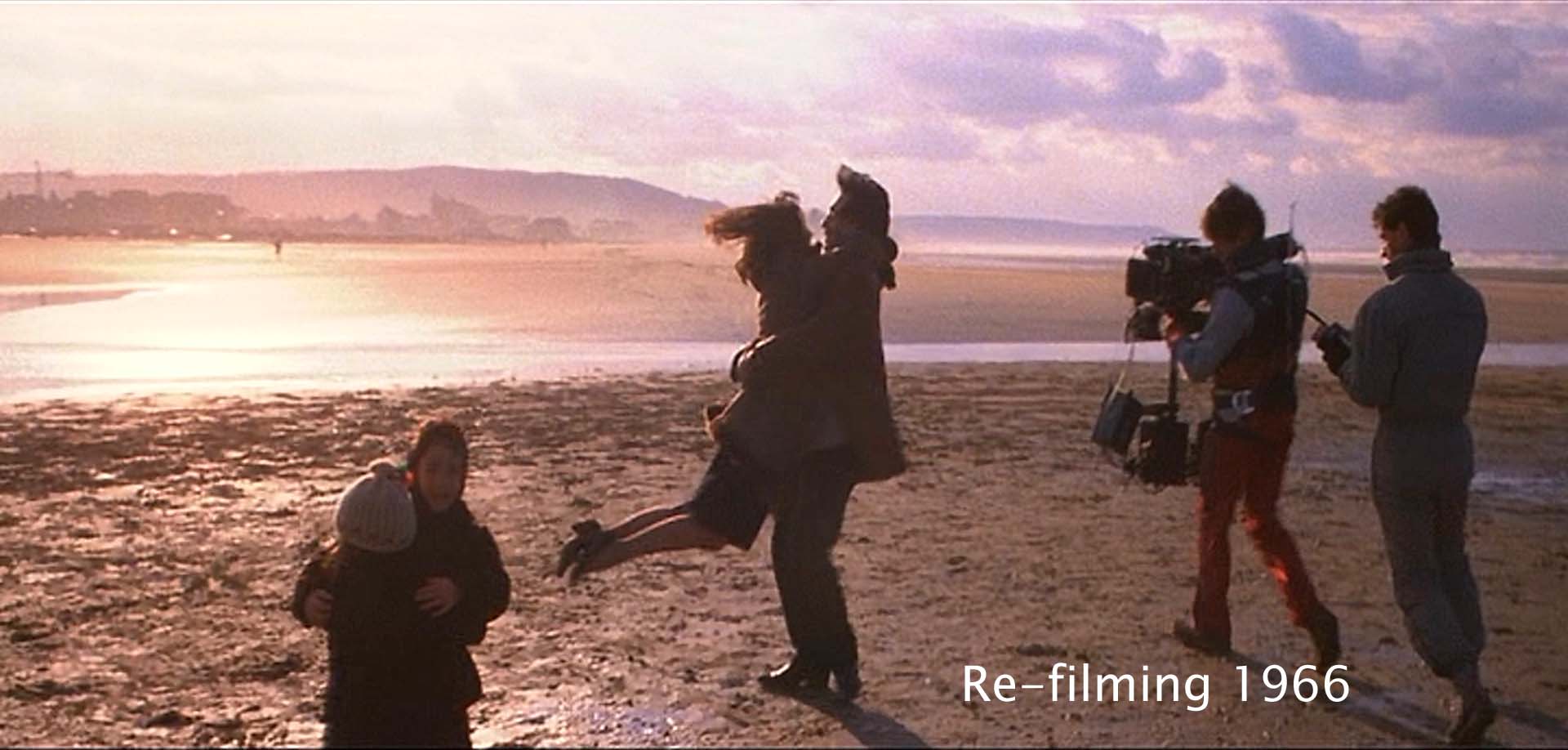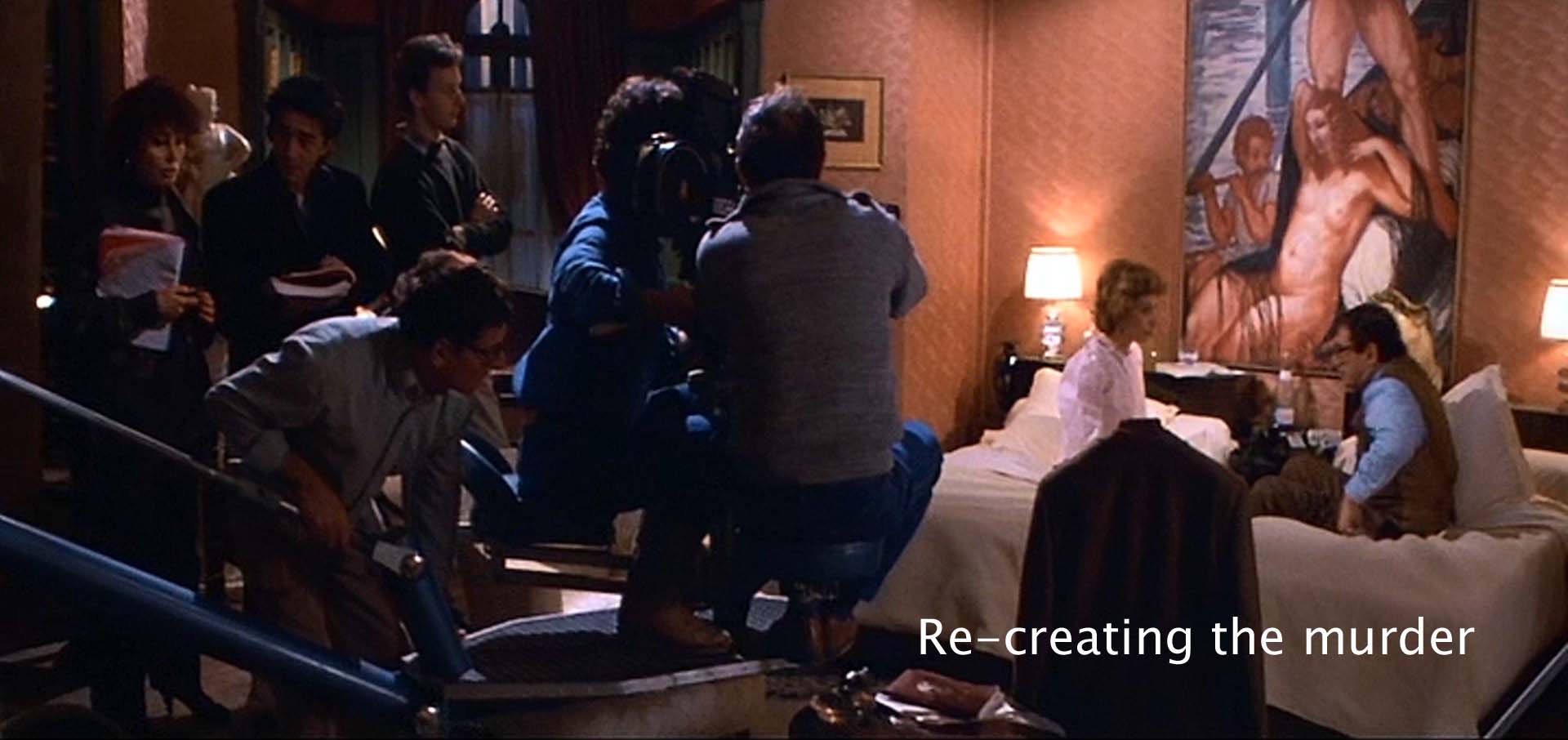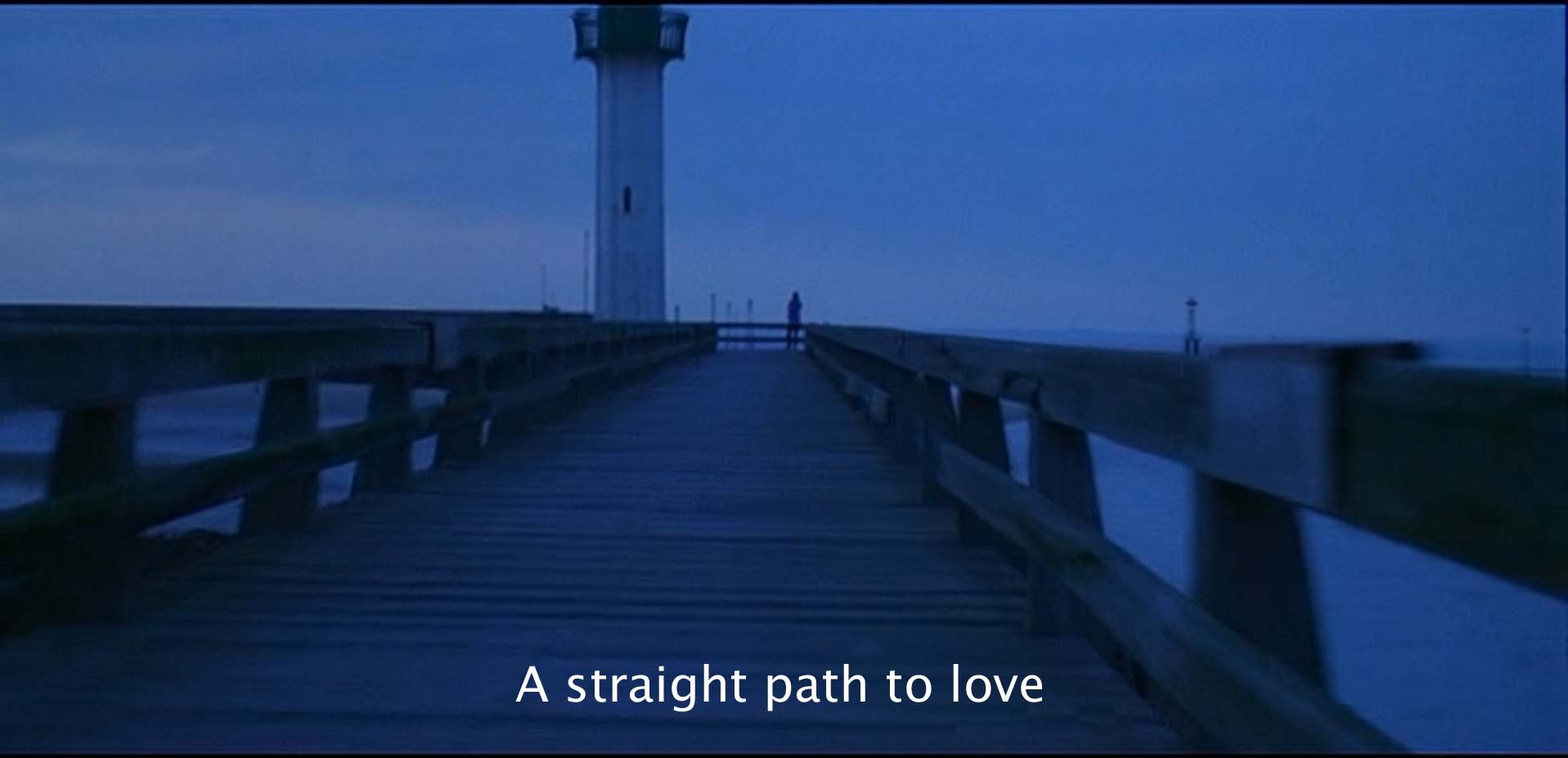Enjoying: This is a hard film to like. It’s complicated. It refers repeatedly to an earlier film that you may well not have seen. It’s a metafilm. I suggest you read the essay before seeing the film.
Enjoying: Pay attention (as always!) to the opening and closing sequences. They state one informing idea of this film, here, straight driving from start to finish as opposed to the tangle in the middle.
It helps, in seeing this film, if you have already seen Lelouch’s A Man and a Woman of 1966 to which it is a sequel. In fact, I think you can hardly understand this one if you haven’t seen that one. In the earlier film, Jean-Louis Duroc (Jean-Louis Trintignant) and Anne Gauthier (Anouk Aimée) are widower and widow respectively. They visit their children at a boarding school in the seaside resort of Deauville. He is a racing car driver, she a script supervisor in movies. Driving back and forth between Paris and Deauville a romance grows, but a final onscreen embrace is ambiguous.
This film has the same director, the same principal actors, but it is very different—far more complicated and hard to follow. I’m offering a fairly long synopsis in hopes of helping you.
When this film opens, it is clear that the earlier romance did not last. Jean-Louis (Trintignant again) and Anne Gauthier (Anouk Aimée again) have lived in separate worlds. Jean-Louis has changed from racing driver to organizer of races, and he lives with and admires his son Antoine (Antoine Sire) in a houseboat on the Seine. Antoine has grown up from the earlier film and he now races speedboats. In fact, he and his bride arrive on a speedboat for the reception aboard the houseboat. There, a young woman, the bride’s sister, Marie-Sophie (Marie-Sophie Pochat) picks up Jean-Louis, telling him she wants to go on one of the auto rallies he manages. They become lovers.
Anne has become a big-time film producer, and we see her finishing a World War II movie starring her daughter Françoise (Evelyne Bouix), also grown up from the 1966 film. She has become an actress and has a child, a daughter. We see her briefly in one scene. Her chief function apparently is to make Anne a grandmother.
Anne’s World War II movie flops disastrously. We suddenly go, though, to what seems a totally irrelevant plot. A serial rapist and killer, Cortal, escapes from a mental hospital. He contacts his wife and daughter and his psychiatrist, Professor (or Doctor) Thevenin who announces on television that Cortal is really cured and just wants freedom.
Anne needs another film right away to recover from the failed World War II film. She decides that her and Jean-Louis’ “story” would make a good movie. She meets him, but at first, though friendly enough, he refuses permission. “We never had a story.” (But there was that film!) Jean-Louis goes to the studio with her and meets the director and stars of the proposed movie (Anne’s daughter and a famous in real-life singer-actor, Richard Berry). Flattered, Jean-Louis agrees. He and Anne end up in bed, and they rediscover their earlier love.
Berry is only one of several real-life people who appear in the movie who would be well known to a French audience. Anne’s current boyfriend (being replaced by Jean-Louis) is Patrick Poivre d’Arvor, a well-known anchorman on French tv. Robert Hossein is a noted writer, actor, and director. Thierry Sabine is a driver in the Dakar rally both in the film and real life. And there are others. Lelouch is playing games with reality here. Are these characters fictional? No, they are real. Is this film a fictional film or does it document reality?
Matters get really complicated once we get to the studio and the set. We in the audience see Anne and her director filming. We see cameras, microphones, grips, and lights. What we see then is a film of filming. It purports to be “reality,” and the film is now doubly a fiction. Then we in the audience begin to see clips from the previous 1966 film. These bits of the 1966 film become physical realities included in the photography of physical realities (like the cameras and microphones) in the 1986 film.
We have two levels of reality now. One is the usual filmic convention that what we are watching, the 1986 film, represents a photographed reality that is a fiction. The other is that the physical 1966 film clips (and the reality that they represent) are part of the physical reality being filmed in the 1986 film. The 1966 film is not a representation of a fictional reality, then. It is a fact like the tables and food in the 1986 film. The physical 1966 film is as factual as the events photographed in the 1986 film, Cortal’s escape for example. These clips and our seeing cameramen and sound people promote Lelouch’s 1986 film into a metafilm, that is, a film that tests the relation of a fictional film to physical reality. As my friend Ron Nutter put it, “This is a film about filming a film about filming.”
One of the characters says, “A simple story needs to stay simple,” but Lelouch has spurned that good advice, as does Anne. She has remade the earlier film as a musical, and it is terrible. And Lelouch has made the simple 1966 film into a metafilm.
Meanwhile, Jean-Louis has told Marie-Sophie that he is leaving her for Anne. Nevertheless, they have gone off together to participate in a rally in the Saharan desert. She is broken-hearted and demands to be taken to a plane for Paris. The two of them set out, but she sends him off in the wrong direction, destroys the radio, and dumps their drinking water, wanting them to die together in the best tradition of the French grande passion. Much suspense ensues and thirst and sandstorm and sunburn, although, being French, Jean-Louis continues to smoke his Gauloises.
Anne has given up remaking the 1966 film and shifted to a new film based on the Cortal/Thevenin story. In this film, she is aided by the well-known anchorman who is her now abandoned boyfriend. He has got hold of an autopsy report and, based on that, Anne makes a movie accusing Thevenin of using Cortal to mask his own murder of his wife. Now, the ostensibly real story of Cortal/Thevenin (reported by a real television journalist) becomes a fiction. But it is true! Thevenin confesses! Are we dealing with fiction or reality? To confuse matters further, the same actors who portrayed Cortal and Thevinin in the seemingly “real” escape and murder now appear in the film (including the real-life personality Richard Berry).
Critic David I. Grossvogel noticed a cute touch. In the “real” Cortal escape, we glimpse a movie on a television screen. It is Hitchcock’s Dial M for Murder in which Ray Milland arranges for someone else to murder his wife, Grace Kelley, quite apropos here, where Thevinin is fitting Cortal into the murder of Thevinin’s wife. But when Anne films the same situation, her television set has just some random violence. Lelouch is subtly suggesting, says Grossvogel, that his own filming is a lot more skillful than his character’s, Anne’s.
In the desert, Marie-Sophie and Jean-Louis are rescued by some Tuaregs, and they return to Paris, Marie-Sophie proudly proclaiming on television her attempt to kill them both. But the movie proceeds to its happy ending. Anne and Jean-Louis cheerily watch speedboats in a race up and down the Seine (Antoine in fourth place). We see fictional daughter Françoise tie up with real person Richard Berry. We see Marie-Sophie happily engaged again in the rally in the Sahara. And we flash backward into the 1966 movie and forward, then backward, in the 1986 movie to see Anne and Jean-Louis return to Deauville, site of their first romance, and there resolve to quit smoking. A long boardwalk leads in a straight line from him to her. Then the last shot of this film is a clip of an exuberant embrace, Jean-Louis and Anne, from the earlier film combining straight-line running by him and circular embracing by both of them.
The last shot, in other words, carries out Lelouch’s metafilmic idea. The 1966 romance of Anne and Jean-Louis is physical, historical fact so far as the new film incorporates the old film, but it is a photographed fiction in the new film.
What is real here, what fictional? The Cortal/Thevinin story is both. Curiously, the second version, Anne’s film, is “realer” than the first: it tells the “real” story, namely that Thevinin used Cortal to murder his wife. When Thevenin confesses, Anne's film has "created a reality." Anne and Jean-Louis exist on two levels, a past fiction that is a present reality. The various actors in this film who play themselves are both real and fictional. Other actors have the same first names in real life that they have in the film (Jean-Louis, Marie-Sophie, Antoine). Lelouch is playing with the very idea of the fictional film.
But there are other themes. I suggested for the earlier film a contrast between male and female. Jean-Louis plays out the straightforward, speedy, start to finish of a prototypical male. Anne plays out the more circuitous, roundabout style of a prototypical female—prototypical as presented by Lelouch (and I should think by Freud). Lelouch continues that same theme here. We begin the film with an otherwise irrelevant race involving Jean-Louis, his son, and other men. During the course of the film, we see Anne starting and stopping her films and her relationships, her camera (a Steadicam) going round and round. We see Marie-Sophie’s disastrous rerouting in the desert. And we see Anne’s daughter give up one relationship and start another.
These two “prototypical” styles are anatomically or biologically defined—I am, after all, a psychoanalytic critic. There are other biological issues. Jean-Louis comments repeatedly on the disparity in age between himself and Marie-Sophie and whether they can “grow old together.” Aging is an issue, most obviously the twenty years since Anne and Jean-Louis’s first romance. The very title of the movie says it: vingt ans déjà, twenty years later instead of what one would normally say, vingt ans après, twenty years after.
The film often refers to food, the canteen on the movie set, the restaurant where Anne and Jean-Louis discuss “their” movie, or the food and water that Marie-Sophie dumped in the desert. And there are those fish we glimpse in the hold of the houseboat.
And, of course, this being a French film, it deals extensively with various sexual relationships between male and female. There is even that daughter of Françoise’s and Anne’s being a grandmother.
That, it seems to me, is the most interesting thing about this movie: it juxtaposes an exploration of the relation between reality and fictionality, a very abstract idea, with the down-to-earth biology of us as human animals. However, neither the general public, the critics, nor I like this film very much. The earlier one I thought suffered from having a lot of extraneous material in it. This one has even more. But I think it integrates the odds and ends better. I think it's curious juxtaposition of metafilm and raw biology makes it something of an achievement, more interesting, really, than the first A Man and a Woman.

